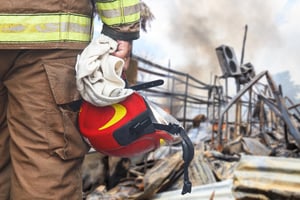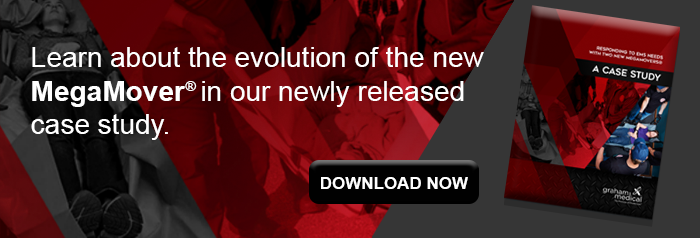 First responders often contend with unusual stressors when tackling casualty evacuation during disaster response — like reaching (and later moving) victims from hot zones or hard-to-reach places. Their response time has a significant impact on survival rates. As such, equipping them with the training and tools they need to work efficiently and safely can mean the difference between a patient’s life and death.
First responders often contend with unusual stressors when tackling casualty evacuation during disaster response — like reaching (and later moving) victims from hot zones or hard-to-reach places. Their response time has a significant impact on survival rates. As such, equipping them with the training and tools they need to work efficiently and safely can mean the difference between a patient’s life and death.
With an increase in mass casualty incidents in recent years, first response teams are under more pressure than ever before to be disaster prepared. Whether it’s an active shooter incident or natural disaster, your casualty evacuation plan needs to be reviewed and updated regularly to ensure that your EMS team members are able to respond to disaster, and evacuate victims, efficiently and safely.
Here are five things to keep in mind when reviewing the casualty evacuation aspect of your disaster response plan:
1. Budget Constraints
As we’ve discussed in a previous blog post, shrinking budgets are forcing first response teams to do more with less during disaster response. Whether in EMS, firefighting or law enforcement, budget constraints will affect both the size of the team you can employ and train, and also how well you can equip them.
When you’re planning for casualty evacuation, look for an intelligently designed, affordable patient transport solution made from the highest-quality materials. You’ll also want to prioritize those that get victims out of harm’s way using the least amount of personnel.
2. Cross-Departmental Collaboration
We’ve mentioned before how active shooting incidents have sparked a growing collaboration between first responders. Usually, smaller emergencies fall into categories that naturally designate situational leads. For example, a firefighting team would head up a response to a fire, while paramedics lead responses to health emergencies. Active shootings and natural disasters, however, require each team to have tactical knowledge on how to deal with these scenarios and rely on interdepartmental coordination to ensure victims and personnel remain safe.
Any casualty evacuation plan you develop has to take into account that you may have to rely on the help of non-professionals when getting victims out. Prioritize stocking your inventory with equipment that’s easy-to-use and intuitive for lay persons when working under pressure.
3. Working with Partner Agencies
In any disaster response scenario, a network of agencies may need to work together to provide coordinated relief. Depending on the size and nature of the disaster, you may find yourself supervising a team of responders working alongside:
- Local government agencies: They’re the first to respond to any disaster. Each local authority is tasked with having an emergency management plan in place that includes activating an Emergency Operations Center (EOC). These agencies keep the state emergency management agency informed of developments and can call on state and federal assistance if necessary.
- State agencies: If the local authorities are overwhelmed by the scale of a disaster, state agencies coordinate the supply of additional resources. State governors have the authority to declare a state of emergency.
- Federal agencies: The Federal Emergency Management Agency (FEMA) shares resources with states and local authorities who can’t provide adequately for a disaster on their own. Once a request for federal assistance is signed off by the President, FEMA will assign personnel and resources to an emergency response team and coordinate assistance from a disaster field office.
Get more details on each agency's role in disaster management and which tools are designed to help them.
4. The Need for Specialized Equipment
When you’re deploying a disaster response plan, you’ll need specialized equipment tailored for use in extreme circumstances. EMS teams working under immense pressure need all the help they can get to keep themselves, and any victims, safe and to respond quickly. When you’re equipping a team for casualty evacuation, the tools they use need to be well-made and intelligently designed.
Features to look out for include:
- Durability: Can it be used in extreme environments without breaking down?
- Ease of storage: Is it easy to store? Equipment should take up minimal space in the vehicle.
- Rapid Deployment: Can it be quickly and easily deployed?
- Load-bearing capability: Can it accommodate patients of varying sizes and weights?
- Responder Safety: Is it designed to prevent responders from injuring or straining themselves?
- Efficiency: Does it require a minimal number of responders to safely extricate the victim?
- Visibility: Does the design accommodate disaster scenarios where the units visibility has an impact on security? For example, an active shooting may require use of equipment designed for decreased visibility.
5. Choosing the right suppliers and products
When you’re dealing with disaster, it’s vital that you have a medical equipment supplier that won’t let you down. Building long-term partnerships with reputable companies will ensure your team has the quality equipment they need, when they need it. It also helps you stay ahead of the latest developments in the tools your team could use to perform better and more efficiently.
Graham Medical pride themselves on the quality of their client relationships and their commitment to innovation. As leading suppliers of emergency medical products, we are known for intelligently designed equipment that takes the extremes of disaster into account.
Take our casualty transport solutions, the MegaMover® Tactical and MegaMover® Disaster Response transport units, for instance. These MegaMover® units were designed with input from experienced first responders to ensure that they meet the unique demands of casualty evacuation during disaster response.
They are specifically:
- Designed for use over difficult/uneven terrain to get casualty victims out of hard-to-reach places.
- Durable and lightweight, with a non-woven latex-free construction.
- Easy to store and transport, occupying little vehicle space.
- So quick and easy to deploy that even civilians would be able to help, without wasting valuable time figuring out how to use it.
- Able to carry loads of 350-1000 lbs., depending on the model.
- Designed to prevent injury and strain by supporting ergonomic lifting.
- Extremely efficient. The MegaMover Tactical® can be used safely by a single responder, and the MegaMover Disaster Response® can be safely used by as little as two responders per victim.
- Designed with safety in mind, their gray color reduces visibility in situations with a security risk.
Maximize your team’s efficiency in times of disaster response. Learn more about how MegaMover® products are leading the way in patient transport in hostile and unpredictable environments — helping keep victims and responders safe.

